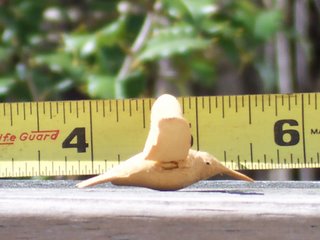Carving and Whittling: Traditions Handed Down

Image Left: A few of my decorative carvings: The songbirds are full size, the Canada goose is ¼ scale, and the pintail is ½ scale.
The tradition of carving and whittling in the Blue Ridge goes back to the North American Indians who carved, among other things, wooden fish-hooks and pipes. Whittling is the art of carving shapes out of raw wood with a knife, as in the whittling of a toy. It is a tradition that has been practiced worldwide for centuries.
Sometimes the terms "whittling" and "carving" are used interchangeably, but this is incorrect. Carving implies the use of chisels, gouges, and a mallet, while whittling implies only the use of a knife.

Image Right: A happy customer with a 1/3 scale decorative wood duck.
I can remember my Granddaddy, sitting in an old rocking chair on his North Carolina porch, on Sunday afternoons whittling with an old pocket knife. Sometimes he would whittle one of us kids a toy but mostly, he would just whittle a piece of wood about the size of a 2x2 a foot long or so, until it was nothing but shavings on the floor of the porch.
Power tools are used in carving these days like the popular Dremel rotary tool, routers, and saws. Wood burning with an electric tool is also employed in the detailing of modern carvings.
I use all of these tools in my carving but my primary tool is the knife. I have a rather extensive collection of bought carving knives but nowadays I use knives that I have made exclusively for my carvings; I can shape the blades whatever shape that best services my needs and the handles always fit my hand perfectly for optimum comfort.

Image Left: A work in progress; a miniature hummingbird in flight.
For carvings that will be painted like the decorative songbirds and waterfowl in the images you see accompanying this article I use Tupelo and basswood; they both are soft woods with a fine grain that resist splitting. I have carved in walnut, maple dogwood, cedar, white pine, yellow pine and a host of exotic woods.
I use acrylic paints that are watered down to a thin wash, and several coats are applied.
On carvings of standing ducks or geese I carve the legs and feet also, but songbirds, birds of prey, and most other birds I use a strand of leader wire to represent each toe, or claw (talon), and bind them with multiple wrappings of nylon thread and glue to give them the girth needed and form a texture that looks very similar to the birds actual legs.

Image Right: A work in progress; full size male and female Bluebirds.
The eyes are almost always glass which I order from a specialty glass eye manufacturer; the more expensive ones are hand made by the same supplier.
There are a lot of good carvers and whittlers in this world and the Blue Ridge Mountains are full of them and with spring coming there will be a great number of arts and crafts shows going on throughout the region. So, get out and check out some of these shows and see the wealth of offerings.
Happy Carving and Whittling!
Technorati Tags: [Blue Ridge][Traditions][North American Indians][carving][whittling][North Carolina][Canada goose][pintail][hummingbird][Bluebirds][wood duck]












4 Comments:
At Tuesday, 14 March, 2006, The MacBean Gene said…
The MacBean Gene said…
Those are very nice DL. You are a extremely talented fellow.
I was always told that whittling was more the activity that your Grandfather did with no particular object in mind but the satifaction of a knife through wood.
At Wednesday, 15 March, 2006, Leslie Shelor said…
Leslie Shelor said…
Beautiful work! Lots of old timers around here practiced whittling that resulted in a pile of shavings!
At Wednesday, 15 March, 2006, D L Ennis said…
D L Ennis said…
You both are very kind...thank you!
At Thursday, 16 March, 2006, Mark said…
Mark said…
So lifelike! Very cool! I'll have to share some of my handywork in the future. All the photos were taken long before the digi cam was invented, so I'll have to do some scanning. Thanks for sharing those with us. Do you sell your stuff?
Post a Comment
<< Home